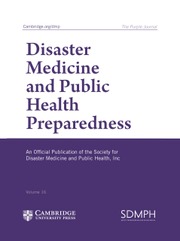In England, the Civil Contingencies Act 2004 (CCA), National Health Service (NHS) Standard Contract Service Conditions, and NHS England Emergency Preparedness, Resilience, and Response (EPRR) Framework require NHS-funded organizations to be able to respond to emergencies for the provision of health care. 1 - 3 The CCA defines an emergency as “an event or situation which threatens serious damage to human welfare in a place in the United Kingdom … if it involves, causes or may cause … loss of human life, human illness or injury, … or disruption of services relating to health.” 1 (s.1)
The NHS England EPRR Framework “describes how the NHS in England will go about its duty to be properly prepared for dealing with emergencies”. 3 (p.4) It states “Category 1 responders are those organisations at the core of emergency response” and that Category 1 responders for health care include NHS Trusts which provide “hospital accommodation and services in relation to accidents or emergencies.” 3 (p.12)
The CCA requires Category 1 responders to “maintain plans for the purpose of ensuring, so far as is reasonably practicable, that if an emergency occurs the person or body is able to continue to perform his or its functions.” 1 (s.2(1)(c)) The Civil Contingencies Act (Contingency Planning) Regulations 2005 require that “[e]very plan maintained by a general Category 1 responder … must include provision for the carrying out of exercises for the purpose of ensuring that the plan is effective.” 4 (s.25(a)) The NHS England EPRR Framework states “Learning from exercises is central to developing a method that supports personal and organisational goals and must be part of an annual plan validation and maintenance programme.” 3 (p.31)
The NHS England EPRR Framework also states that if an organization activates its plan or Incident Command Centre in response to a live incident then this replaces the need to run a live play or command post exercise, respectively, “providing lessons are identified and logged and an action plan developed.” 3 (pp.31-32) However, the Framework does not override the Contingency Planning Regulations’ requirement to carry out exercises.
Methods
Study Setting and Design
This was a review of the EPRR exercise frequency of NHS Trusts in England which provide general hospital accommodation and services in relation to accidents or emergencies. At the time of review, there were 122 such Trusts. 5 The review size was determined by the number of these Trusts. The review timing was 1 year after the level 3 national incident for the NHS Coronavirus disease 2019 (COVID-19) response was stepped down in May 2023Reference Pritchard and Sloman 6 and 2 years after the national incident level for the NHS COVID-19 response was reduced from level 4 to level 3 in May 2022.Reference Pritchard and Sloman 7
The outcome of interest was the number of Trusts having a record of conducting their most recent exercises in accordance with the minimum frequencies required by the NHS England EPRR Framework. 3
Approval for this review was not required by the Research Ethics Committee at University Hospitals Sussex NHS Foundation Trust.
Patient and Public Involvement
No patient nor public involvement.
Results
The types of exercises and minimum frequencies of exercises required by the NHS England EPRR Framework, 3 and the number of Trusts having a record of their most recent exercises in accordance with the minimum frequencies are shown in Table 1.
Regarding live play and command post exercises, some Trusts stated that activating their plan or Incident Command Centre in response to a live incident satisfied their statutory requirements.
Limitations
It was not possible to explore further Trusts’ reasons for not holding records of conducting their most recent exercises in accordance with the minimum frequencies required. The NHS in England was in a level 4 national incident for the COVID-19 response between December 2021 and May 2022. This may have impaired the Trusts’ ability to conduct EPRR exercises. The Trusts’ need to record lessons from exercises means they would have no reason to conduct an exercise and not keep a record of it.
Discussion
Over one fifth of Trusts did not have a record of conducting communications systems exercises in the past 6 months in accordance with the minimum frequency required.
Some Trusts incorrectly stated that activating their plan or Incident Command Centre in response to a live incident satisfied their statutory requirements. This suggests lack of knowledge that the NHS England EPRR Framework does not override the requirement of the Civil Contingencies Act (Contingency Planning) Regulations 2005 to carry out exercises.
NHS England might benefit from reviewing how it monitors compliance with its EPRR exercise requirements. It might also benefit from reviewing how its EPRR Framework contradicts the Civil Contingencies Act (Contingency Planning) Regulations 2005 regarding the need to run live play and command post exercises.
Conclusion
NHS Trusts which provide hospital accommodation and services in relation to accidents or emergencies are required by law to conduct EPRR exercises. 4 NHS England provides the highest level of EPRR guidance for NHS Trusts in England, which specifies the minimum frequencies of these exercises. 3 One year after the national incident for the NHS COVID-19 response was stepped down, over 1/5 of these Trusts did not have a record of conducting a communications systems exercise in the past 6 months as required by NHS England.
This review may also be of interest to other state-level bodies which specify high-level EPRR requirements to health care providers.
Author contribution
William Wetherell is the sole contributor to this manuscript.
Funding statement
This research received no specific grant from any funding agency in the public, commercial, or not-for-profit sectors.
Competing interests
The author is a bank employee of University Hospitals Sussex NHS Foundation Trust and has no other conflicting interests.
Ethical standard
This review is a quality improvement project and so approval was not required by the Research Ethics Committee at University Hospitals Sussex NHS Foundation Trust. https://www.uhsussex.nhs.uk/research-and-innovation/information-for-researchers-and-healthcare-professionals/is-my-study-research/
Declaration of patient and public involvement
No patient nor public involvement.




